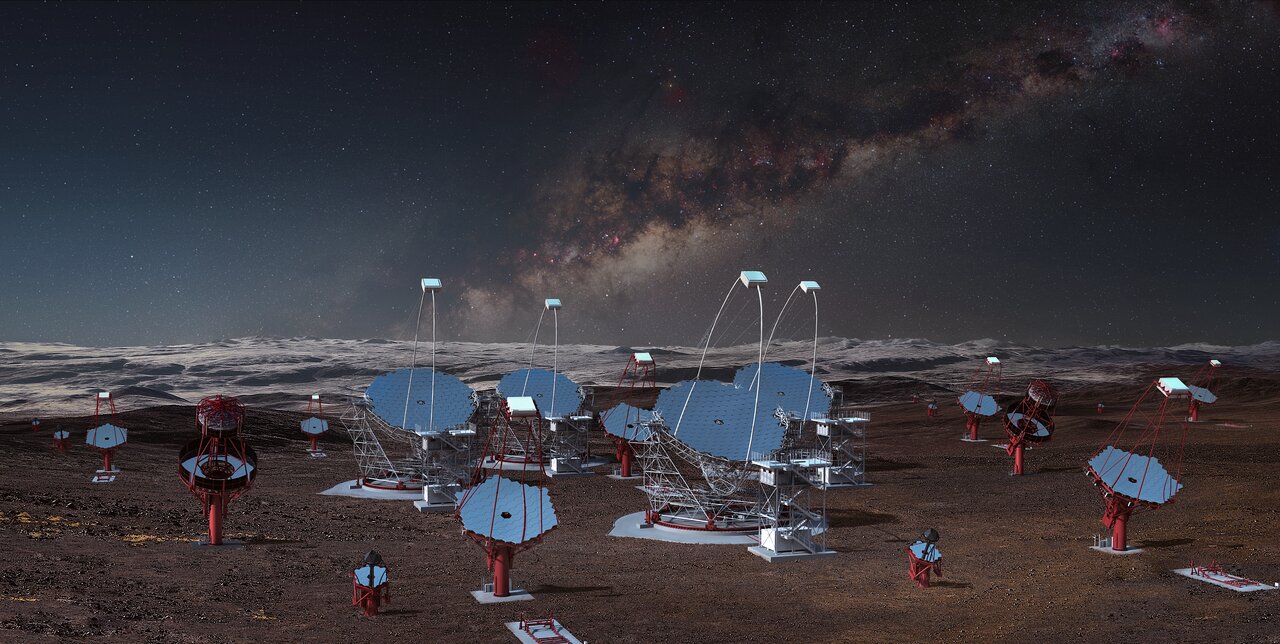Cherenkov Telescope Array Observatory
CTAO — the World’s Most Powerful Ground-Based Gamma-Ray Observatory
The Cherenkov Telescope Array Observatory (CTAO) will be the world’s most powerful ground-based observatory for very high-energy gamma-ray astronomy. It will consist of two arrays of telescopes, a southern-hemisphere array at ESO’s Paranal Observatory and a northern array on the island of La Palma, Spain. Gamma rays are emitted by some of the most extreme and powerful objects in the Universe, such as supermassive black holes and supernovae. It will be the first “open” gamma-ray observatory: its data and analysis software will be made available worldwide (after a proprietary period), engaging a wide research community in astronomy and high-energy physics.
The CTAO, with its large collecting area and wide sky coverage, will be the largest and most sensitive high-energy gamma-ray observatory in the world. The two arrays will detect gamma rays with unprecedented accuracy and together will be up to 10 times more sensitive than existing instruments.
Three types of telescopes are required to cover the full CTAO’s energy range (20 gigaelectronvolts [GeV] to 300 teraelectronvolts [TeV]). Over its core energy range (150 GeV to 5 TeV), the CTAO will employ 23 Medium-Sized Telescopes distributed over the two array sites, accompanied by 4 Large-Sized Telescopes in the northern hemisphere array, and 37 Small-Sized Telescopes in the southern array (optimised to reach energies below 150 GeV and above 5 TeV, respectively).
For the current approved layout, the so-called Alpha Configuration, the CTAO will comprise 64 telescopes worldwide, with 13 telescopes in the northern hemisphere and 51 telescopes in the southern hemisphere. The northern hemisphere site (CTAO Northern Station) is located at the Instituto de Astrofísica de Canarias Observatorio del Roque de los Muchachos on the island of La Palma in the Canary Islands. The southern site (CTAO Southern Station) is located at ESO’s Paranal Observatory, around ten kilometres southeast of the Very Large Telescope. This is one of the driest and most isolated regions on Earth — an astronomical paradise. Integrating the CTAO into the existing Paranal–Armazones infrastructure will allow it to take advantage of ESO’s state-of-the-art facilities.
The CTAO counts on the international support of a growing number of shareholders that compose the CTAO Council. ESO is one of the CTAO Council members, as well as CTAO’s hosting partner.
Science with the CTAO
The CTAO will serve as an open facility to a wide astrophysics community. Its scientific potential is extremely broad, from understanding the role of relativistic cosmic particles to the search for dark matter. Observations made with the CTAO will aim to understand the influence of high-energy particles in the evolution of cosmic systems, and to study some of the most extreme and violent events that occur in the high-energy Universe. The CTAO will probe environments from the immediate neighbourhood of black holes to the cosmic voids on the largest scales. It may even lead to brand new physics as it studies the nature of matter and forces beyond the standard model.
Although the Earth’s atmosphere prevents gamma rays from reaching the surface, their interactions with the atmosphere create ultra-high energy particles. These particles travel faster than the speed of light in air and as a result they emit a flash of eerie blue Cherenkov radiation — similar to a sonic boom created by an aircraft exceeding the speed of sound. The CTAO’s mirrors and high-speed cameras will capture these short-lived flashes and pinpoint their direction. This will allow each gamma ray to be traced back to its cosmic source, allowing astronomers to address some of the most enduring mysteries in astrophysics.
The CTAO will have the capability to detect gamma rays in the energy range from a few tens of GeV up to hundreds of TeV. At the lower energies, the CTAO will probe transient and time-variable gamma-ray events in the distant Universe; at the higher energies it will push observational astronomy into a previously unexplored part of the electromagnetic spectrum to give a completely new view of the sky.
The CTAO will see the sky in higher energy resolution than ever before, allowing it to search for annihilating dark matter particles, and it will also be able to slew rapidly to catch gamma-ray bursts as they explode.
More about the CTAO
- Read more on the CTAO website
- Paranal Observatory First Choice to Host World’s Largest Array of Gamma-ray Telescopes
Cherenkov Telescope Array Observatory (CTAO)
|
